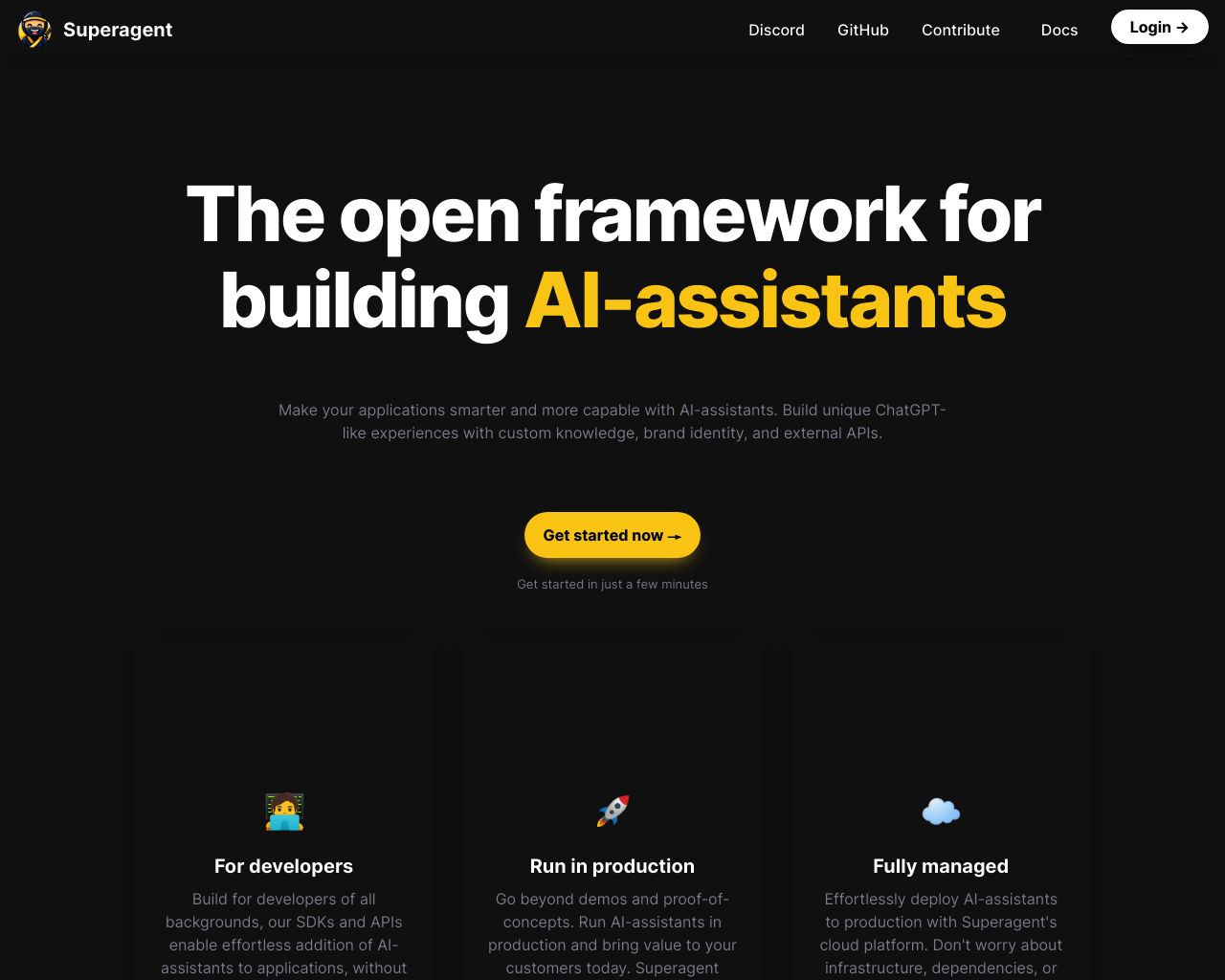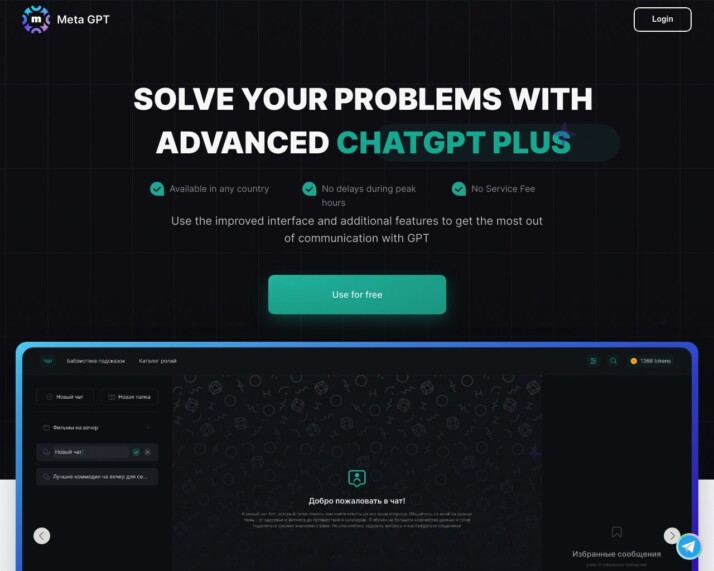Superagent vs. MetaGPT: AI Agent Platforms Compared
AI agent platforms revolutionize software development and task automation. This comparison explores SmythOS, Superagent and MetaGPT, three innovative solutions reshaping how businesses harness AI. Superagent simplifies AI agent creation with no-code tools, while MetaGPT simulates software company structures for complex projects. SmythOS combines user-friendly design with advanced features, offering unparalleled flexibility and security. We examine each platform’s strengths, limitations, and unique approaches to AI agent development, helping you choose the best solution for your needs.
Superagent Overview
Superagent empowers developers to create, host, and manage AI agents without complex coding. The platform streamlines the process of building autonomous agents for web research, sales automation, and data analysis.


Superagent’s key features include no-code customization, memory capabilities for context-aware responses, and integration with various APIs and external tools. The platform supports both local and cloud installations, catering to development and production environments. Superagent leverages large language models to enable AI agents to perform tasks like question answering, content generation, and workflow automation.
Superagent empowers developers to create, host, and manage AI agents without complex coding. The platform streamlines the process of building autonomous agents for web research, sales automation, and data analysis.
While Superagent offers robust functionality, it lacks some advanced features found in competing platforms. The absence of a visual builder and limited explainability tools may pose challenges for users seeking more intuitive design options or detailed insights into agent decision-making processes.
Superagent integrates seamlessly with popular tools and APIs, enhancing its versatility. The platform supports various data sources, including sitemaps, YouTube transcripts, and multiple file formats, expanding the range of information AI agents can process and analyze.
In the competitive landscape of AI agent builders, Superagent stands out for its focus on simplicity and integration capabilities. However, users requiring advanced features like multi-agent collaboration or extensive analytics may find the platform’s offerings somewhat limited compared to more comprehensive solutions.
MetaGPT Overview
MetaGPT revolutionizes multi-agent collaboration in AI by combining human Standardized Operating Procedures (SOPs) with advanced Large Language Models (LLMs). This open-source framework simulates a software company’s structure, assigning distinct roles to AI agents such as product managers, architects, and engineers.


MetaGPT’s core philosophy, “Code = SOP(Team),” integrates established human practices into AI-driven processes. The platform breaks down complex tasks into manageable subtasks, each handled by specialized agents. This approach significantly reduces errors common in multi-agent systems, such as cascading hallucinations or logic inconsistencies.
MetaGPT revolutionizes multi-agent collaboration in AI by combining human Standardized Operating Procedures (SOPs) with advanced Large Language Models (LLMs).
The framework generates comprehensive documentation throughout the development process, including requirement documents, design artifacts, and interface specifications. These outputs enhance the final code quality and facilitate better human-AI interaction. MetaGPT supports both local and cloud installations for development and production environments, offering flexibility for various deployment scenarios.
While MetaGPT excels in simulating software development processes, it lacks certain features found in more comprehensive AI agent platforms. The framework doesn’t offer a visual builder or specific features for explainability and transparency. Additionally, there’s no mention of multi-agent collaboration beyond the simulated software development team structure.
MetaGPT integrates with various tools and platforms, including Hugging Face models and Zapier for API connections. It supports multiple data sources such as sitemaps, YouTube transcripts, and various file formats. However, the platform doesn’t explicitly mention features like data lakes, classifiers, or advanced logic capabilities.
In the competitive landscape, MetaGPT stands out for its unique approach to AI agent collaboration. Its strength lies in mimicking human software development processes, making it particularly valuable for complex software engineering tasks. However, users seeking more general-purpose AI agent creation tools or those requiring extensive visual interfaces may find MetaGPT’s specialized focus limiting.
Feature Comparison
Superagent and MetaGPT offer distinct approaches to AI agent development, each with unique strengths and limitations. Superagent excels in simplifying AI agent creation through no-code customization and seamless integration with various APIs and tools. Its user-friendly interface allows developers to build autonomous agents for tasks like web research and sales automation without complex coding. MetaGPT, on the other hand, focuses on simulating a software company’s structure, assigning specialized roles to AI agents for collaborative software development.
A key difference lies in their core components. Superagent provides a straightforward platform for creating individual AI agents, while MetaGPT emphasizes multi-agent collaboration within a simulated software development environment. This distinction impacts their applicability to different use cases. Superagent’s approach suits users seeking quick deployment of task-specific AI agents, while MetaGPT caters to more complex software engineering projects requiring coordinated effort among multiple AI entities.
In terms of security features, both platforms have limitations. Neither Superagent nor MetaGPT explicitly mentions advanced security measures like constrained alignment or comprehensive data encryption. This gap in security features could be a concern for users handling sensitive data or requiring strict AI behavior controls. While both offer some level of integration and customization, they lack the robust security infrastructure found in more enterprise-focused platforms.
Feature Comparison Table
| Superagent | MetaGPT | SmythOS | |
|---|---|---|---|
| CORE FEATURES | |||
| Visual Builder | ❌ | ❌ | ✅ |
| No-Code Options | ✅ | ❌ | ✅ |
| Explainability & Transparency | ❌ | ✅ | ✅ |
| Audit Logs for Analytics | ❌ | ✅ | ✅ |
| SECURITY | |||
| Constrained Alignment | ❌ | ✅ | ✅ |
| IP Control | ✅ | ❌ | ✅ |
| COMPONENTS | |||
| Data Lakes | ❌ | ❌ | ✅ |
| DEPLOYMENT OPTIONS (EMBODIMENTS) | |||
| Staging Domains | ❌ | ❌ | ✅ |
| Deploy as Scheduled Agent | ❌ | ✅ | ✅ |
| DATA LAKE SUPPORT | |||
| Hosted Vector Database | ✅ | ❌ | ✅ |
| Sitemap Crawler | ✅ | ❌ | ✅ |
| YouTube Transcript Crawler | ✅ | ❌ | ✅ |
Best Alternative to Superagent and MetaGPT
SmythOS stands out as the superior alternative to Superagent and MetaGPT, offering a comprehensive platform for AI agent development and deployment. We’ve designed SmythOS to address the limitations of other platforms while providing unparalleled ease of use, an extensive feature set, and support for unlimited use cases.
Our visual builder sets SmythOS apart from both Superagent and MetaGPT. While Superagent offers some no-code options, and MetaGPT focuses on simulating software development roles, SmythOS provides an intuitive drag-and-drop interface that empowers users of all skill levels to create sophisticated AI agents without extensive coding knowledge. This approach democratizes AI development, making it accessible to a broader audience while still offering the depth and flexibility required by experienced developers.
SmythOS provides an intuitive drag-and-drop interface that empowers users of all skill levels to create sophisticated AI agents without extensive coding knowledge.
SmythOS excels in its comprehensive feature set, addressing gaps in both Superagent and MetaGPT’s offerings. We provide robust security features like constrained alignment and data encryption, which are crucial for enterprise-level deployments but lacking in the other platforms. Our platform also offers advanced deployment options, including staging domains and scheduled agents, giving users greater control over their AI solutions. Additionally, SmythOS supports a wide range of data sources and formats, from sitemaps to PDF files, enhancing the versatility of AI agents created on our platform.
Perhaps most importantly, SmythOS opens up unlimited use cases for AI agent development. While Superagent focuses on specific tasks like web research and sales automation, and MetaGPT simulates software development processes, our platform allows users to create AI agents for virtually any application. Whether you’re building a customer service chatbot, an automated data analysis tool, or a complex multi-agent system for enterprise-wide automation, SmythOS provides the tools and flexibility to bring your vision to life.
SmythOS opens up unlimited use cases for AI agent development… our platform allows users to create AI agents for virtually any application.
By choosing SmythOS, users gain access to a powerful, scalable, and user-friendly platform that outperforms both Superagent and MetaGPT in key areas. We’re committed to driving innovation in AI development, making it possible for businesses and individuals to harness the full potential of artificial intelligence across a wide spectrum of applications.
Conclusion
Superagent and MetaGPT offer unique approaches to AI agent development, each with distinct strengths. Superagent simplifies AI agent creation through no-code customization and seamless API integrations, ideal for quick deployment of task-specific agents. MetaGPT excels in simulating software development processes, making it valuable for complex engineering tasks. However, both platforms have limitations in security features and advanced functionalities.
SmythOS emerges as the superior choice, combining the best of both worlds while addressing their shortcomings. Our platform offers a user-friendly visual builder for effortless agent creation, alongside robust security measures like constrained alignment and data encryption. SmythOS supports multimodal interactions, problem-solving capabilities, and seamless multi-agent collaboration, surpassing the offerings of Superagent and MetaGPT.
Unlike its competitors, SmythOS provides unparalleled flexibility in deployment options. We enable you to create agents once and deploy them across various platforms, from APIs and webhooks to site chats and scheduled tasks. This versatility, coupled with our extensive integration ecosystem of over 300,000 connections, positions SmythOS as the most comprehensive solution for businesses seeking to harness the full potential of AI.
Experience the future of AI agent development with SmythOS. Explore our diverse range of AI-powered agent templates to jumpstart your projects, or create a free account to build unlimited AI agents with no time limit. Join the AI revolution and transform your workflow today with SmythOS – where innovation meets simplicity.
Last updated:
Disclaimer: The information presented in this article is for general informational purposes only and is provided as is. While we strive to keep the content up-to-date and accurate, we make no representations or warranties of any kind, express or implied, about the completeness, accuracy, reliability, suitability, or availability of the information contained in this article.
Any reliance you place on such information is strictly at your own risk. We reserve the right to make additions, deletions, or modifications to the contents of this article at any time without prior notice.
In no event will we be liable for any loss or damage including without limitation, indirect or consequential loss or damage, or any loss or damage whatsoever arising from loss of data, profits, or any other loss not specified herein arising out of, or in connection with, the use of this article.
Despite our best efforts, this article may contain oversights, errors, or omissions. If you notice any inaccuracies or have concerns about the content, please report them through our content feedback form. Your input helps us maintain the quality and reliability of our information.
